SAIT Culinary Arts student cooks his way to the top in France
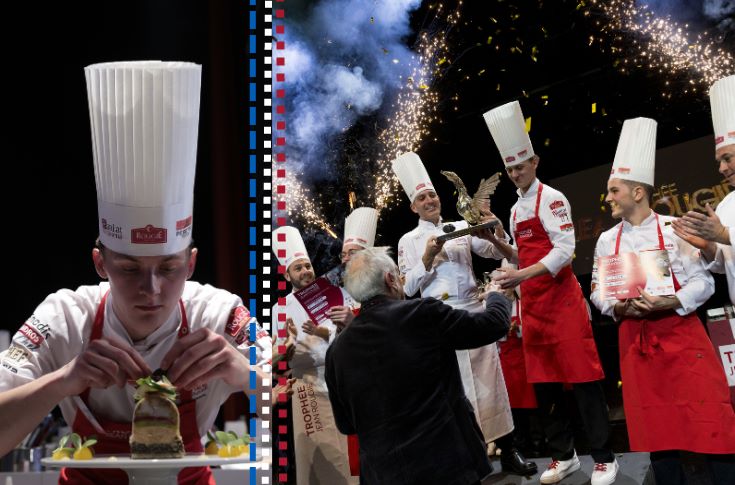
Q&A with Erik Hansen, 2024 Trophée Jean Rougié Winner (photos courtesy of Agence Eligans)
For the first time ever, Canada was invited to compete at the Trophée Jean Rougié — a renowned French culinary contest for rising chefs. SAIT’s Erik Hansen represented Canada and brought home the top prize.
Erik sharpened his knives and skills for the 14th annual culinary competition under the tutelage of SAIT instructors and chefs Andrew Springett and Manuel Panfili. Training started in October 2023, on the heels of a competition in Toronto. Then, he travelled across the Atlantic to Sarlat-La-Canéda, a small medieval town in southwestern France. A translator was on hand to help him navigate the foreign environment, and a local culinary student was a commis to Erik (aka, a junior chef) to help wash dishes and assist him throughout the competition.
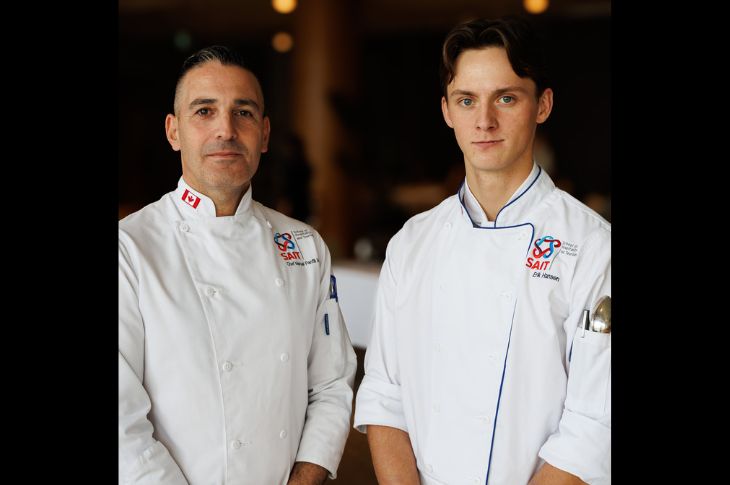
Chef Manuel Panfili and Erik Hansen pose at SAIT before the competition.
The competition, divided into two parts and featuring eight competitors, provided Erik with the opportunity to plate up dishes featuring foie gras and truffle — two staple ingredients in the French culinary tradition. Erik had two and a half hours to put together a beautiful terrine incorporating elements of French and Canadian cuisine. He practiced this cold platter many times before in a Calgary kitchen.
But he only received the theme and requirements for the second part of the competition, the hot plate, 10 minutes before creating it. The black box challenge revealed surprise ingredients with a touch of foie gras and truffle, and specific cooking instructions to test his technique.
We sat down with Erik to find out more about cooking on a world stage and bringing home the gold.
This interview has been edited for length and clarity.
Q&A with Erik Hansen
How would you describe the two main ingredients used in the competition, especially for someone who’s never tried them before?
Foie gras is goose or duck liver, so the closest thing I’d relate it to is a block of butter, but it’s richer and has a meaty flavour. You can sear it without losing too much fat. Truffle is like any fungus or mushroom, but rarer. You need dogs to find them, because they sniff out the truffle that grows underneath oak trees in certain regions of France, such as Dordogne — where the competition was held.
You trained for the cold platter component. How did you put that together?
The cold platter is the main part of the event. We worked hard to develop it, drawing inspiration from different Italian cookbooks — Chef Manuel is Italian — and Chef Springett’s knowledge from being a competitor in Bocuse D’Or in 2003. He used a lot of the same style, and we were able to modernize it.
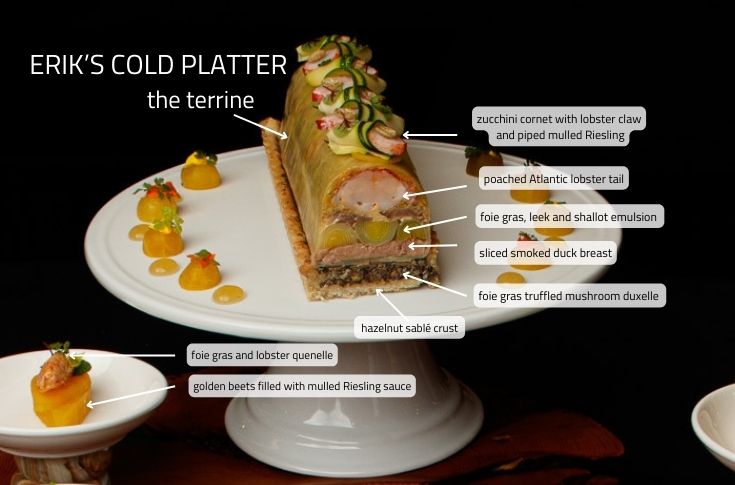
The Black Box Challenge
To make his hot plate, Erik opened a black box to find his ingredients. His collection was seafood-oriented, with specific direction assigned for each ingredient.
He had an hour and 15 minutes to:
- layer truffle between a scallop and sear it
- pan fry the langoustine and razor clam shells, follow his heart with the oysters (so long as they were cooked)
- glaze the carrots with a honey butter glaze
- puree the Jerusalem artichoke (which is a kind of root vegetable)
- thinly slice and make chips out of the potato
- tie it all together with a sauce made with chicken stock
- serve with a piece of seared foie gras
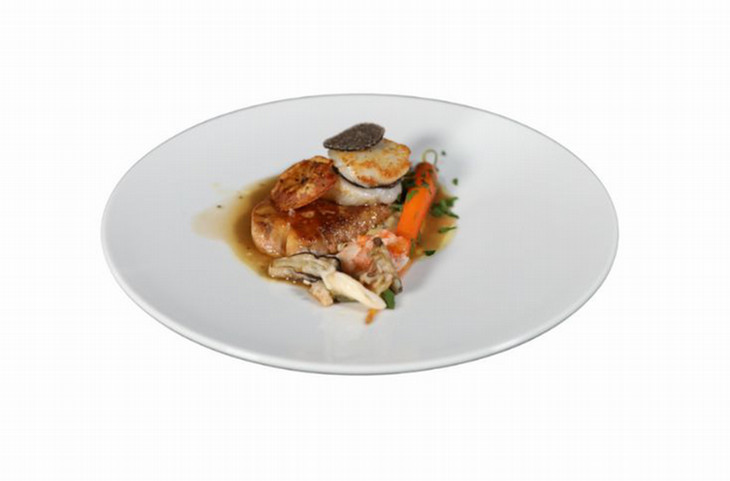
Were there things you really needed to focus on?
Timing is super important. We just kept practicing doing the run to slim it down. Everything cooks differently, so you have to get started in chronological order. There were also always little things like organization and cleanliness, where major points can be deducted. If you’re organized and your kitchen is clean, you have a good chance of success.
How was the kitchen different from what you’re used to?
Everyone is cooking in their own little boxes, so we were practicing in a tight space, which is good. The setup was a little different, and I had different equipment to get used to. The sinks were all the way at the back. We couldn’t bring any of our own electronics because they’re not on European voltage. Luckily, I got to practice on a European oven in Calgary — that was nice.
What piece of advice did you bring with you?
“You can do it here. It’s not going to be much different over there.” I got this from Vince Parkinson, a culinary competition expert, and the manager for the Bocuse team in Canada a couple of years ago. He judged some of our test-run platters.
What was it like when you were actually cooking during the competition?
I had tunnel vision. I didn’t look up for a second because if you look up, it can really throw you off. You’re just kind of talking to yourself the whole time in your head. The adrenaline is going super fast, you’re shaking, and the kitchen judges would ask you questions here and there.
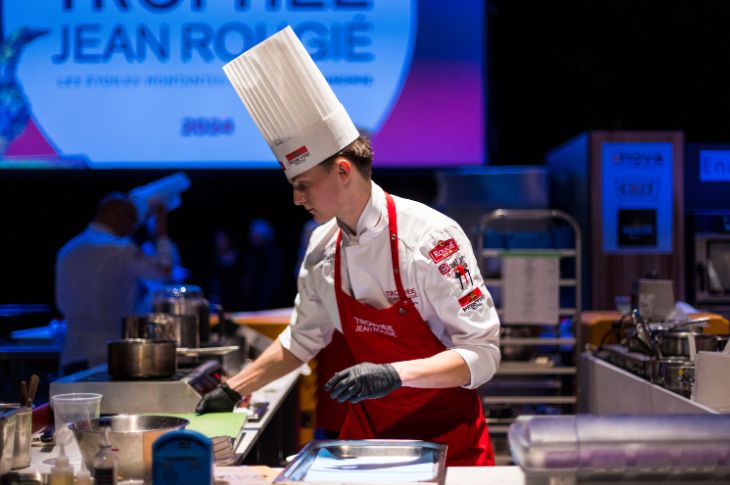
Did your demeanour matter?
It’s super important to look presentable, and like you’re having fun while cooking. If you’re panicking, it doesn’t look good for the food you’re creating, but if you’re having fun … it translates into the final result.
What was it like being the only Canadian among the French competitors?
It was weird, but it didn’t throw me off. I just treated it like a normal competition. I think it was weirder for the French competitors than it was for me. Even after, they were taking pictures of my station, and asking me questions about my practice schedule.
Can you walk me through that moment when you heard you won?
It didn’t really hit me until we were back home. I didn’t believe it at first, that’s for sure. You’re standing up there, looking at everyone. It’s kind of indescribable. It just happened. Everyone was coming up to shake my hand and congratulate me, and take photos. I was signing stuff, so it felt unbelievable, a super big shock. During the cooking, my coach Chef Manuel, could see all the other competitors’ work. Once the second and third went up, which were the top ones he saw, he knew I had a good chance of winning first place.
Aside from bringing home the trophy, are there any other lessons or memories you’re bringing back?
The connections we built out there were super important. If I’m ever back there, I’ll have people to talk to, places to work and go. That alone would have been enough for me.
What’s next?
Travel. I’m still doing the Skills competition this year and the Jeunes Chef Competition in the summer. Whenever I’m free of those two, I feel like Denmark is where I want to go.
Is there anything I didn’t ask you, that you would like people to know?
As cliché as it sounds, believe in yourself, because you can accomplish a lot more than you think.
Rapid fire questions
Sweet or salty? 🎂 People would say I’m a sweet guy for sure.
How often do you sharpen your knives? 🔪 I would say under a month. It all depends how much I use them, too. When you’re practicing every day, you tend to tune them up weekly.
The question you still ask? ❓ The biggest question I still ask, is asking questions. Always being curious is important.
You have one meal to eat for the rest of your life? 🍣 Sushi.
Hobbies outside of culinary? 🚲 I cycle.
Country you would love to visit? ✈️ Denmark. My grandparents are from there.
Ocean or mountains? 🌄 Mountains.
Favourite season? 🍂 Autumn.
A quote that guides you? 📜 “You’re only given a little spark of madness. You mustn’t lose it.” -Robin Williams
If you could have coffee with anyone, who would it be? ☕ Daniel Bouloud. He’s a French chef.
Your turn
Discover a culinary journey that cooks up gold on the world stage— but starts right here at SAIT.
Culinary Arts diplomaGlobal Perspective
We prepare students for successful careers and lives.
SAIT'S
2020-2025
Strategic plan

Oki, Âba wathtech, Danit'ada, Tawnshi, Hello.
SAIT is located on the traditional territories of the Niitsitapi (Blackfoot) and the people of Treaty 7 which includes the Siksika, the Piikani, the Kainai, the Tsuut’ina and the Îyârhe Nakoda of Bearspaw, Chiniki and Goodstoney.
We are situated in an area the Blackfoot tribes traditionally called Moh’kinsstis, where the Bow River meets the Elbow River. We now call it the city of Calgary, which is also home to the Métis Nation of Alberta.